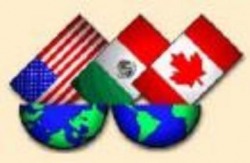WHAT IS NAFTA????
The North American Free Trade Agreement (NAFTA) is one of the most powerful and wide-reaching treaties in the world. It governs the entire spectrum of North American trade and has at its roots hemispheric cooperation on a scale never before seen.
NAFTA is a treaty between Canada, Mexico, and the United States that was designed to foster greater trade between the three countries. NAFTA has been in effect since 1 January 1994. It has since been updated with two major additions, the North American Agreement fo economic Cooperation and the North American Agreement for Labor Cooperation (NAALC). A very recent addition was the security and Prosperity partnership of North America, designed to foster cooperation on issues of national security.
NAFTA attempts to establish a framework for finding solutions to economic problems affecting North America, and to establish cooperation and progress on others. The NAFTA member countries are in different stages of economic development, thus problems relating to balance-of-payments problems, foreign debt and exchange rate fluctuations affect each country according to its strengths and weaknesses. The customs system of the member countries illustrates the technical changes that must take place in order to facilitate trade within the NAFTA agreement. Illegal drugs, ensuring efficient border checks to benefit businesses, consumers, and the government, and tabulating statistics on trade are some functions of US Customs. NAFTA side agreements standardize environmental protection and labor standards, yet the actual enforcement of these standards must be continually monitored. Finally, political challenges of separatist movements in Canada and Mexico have potential economic spillovers and Mexico faces the additional challenges of democratization.


